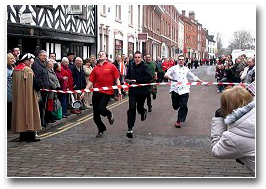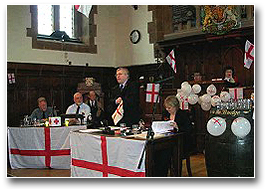Shrovetide Fair & Pancake Toss
Held on Shrove Tuesday at noon on the Market Square and in Bore Street.

The Shrovetide 'Old Fair' was probably in existence long before it was confirmed by Royal Charter of James 1 in 1623, and is still opened with the ancient ceremony. The civic procession arrives at the Market Square for noon, here the Town Crier makes the proclamation to open the fair. The "pan on bell" then sounds from St Mary's steeple and, led by the Mayor and city officials, children rush to claim their traditional free ride.
In former times a court of "Pie Powdre" was then held in Guildhall for "the redressing of all grievances or complaints that shall happen to arise during the time of the fair", but although this is still included in the Crier's proclamation, the Civic party now process to the front of Guildhall to view the more recent custom of the pancake races. The Mayoral party then retires to Guildhall for refreshments and a slice of Simnel cake.
One explanation of the origin of Simnel cake is that a man called Simon and his wife Nell could not agree as to whether the 'plum pudding' should be boiled or baked so the cake was first boiled and then baked producing the Simnel.
St George's Court
Held at noon on St George's Day, 23rd April at the Guildhall (admission free, but space limited) unless St George's Day falls on a Sunday, in which case it is held on Saturday 22nd April.

St George's Court, The Court Baron and View of Frankpledge, commonly known as St George's Court, is an ancient manorial court. The manorial rights of the Barony of Lichfield were transferred by Charter of Edward VI in 1548 to the Bailiffs, Burgesses and Commonalty of the City, which in today's terms are the Mayor, councillors and citizens.
The Court is now held in a light-hearted manner but still appoints the ancient officers of the Manor: 2 High Constables, 7 Dozeners (or petty constables), 2 Pinners and 2 Ale Tasters. The High Constables report on their work over the past year, and a jury is empanelled which imposes fines on those who have rejected the summons to attend, after first hearing their amusing excuses.